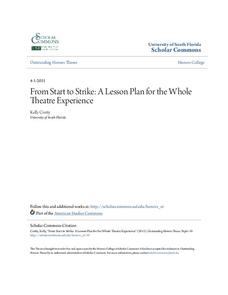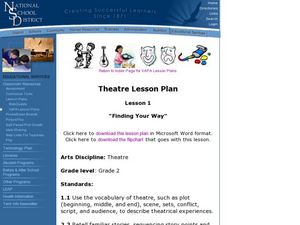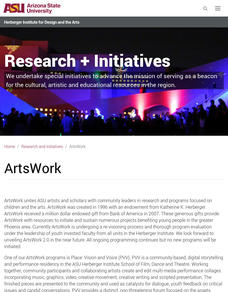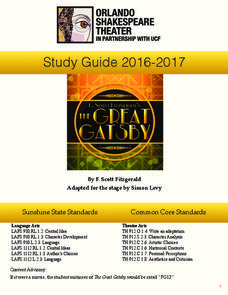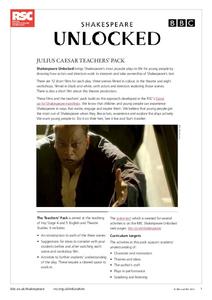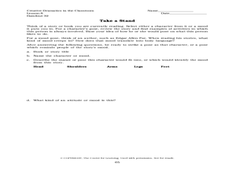Curated OER
How Characters Get What They Want
Sixth graders analyze the primary force that drives a character's actions in a character analysis lesson. In this character analysis lesson, 6th graders analyze how characters present their actions and participate in a group activity...
Brigham Young University
Introducing the Text and Learning the Process of Script Analysis
Where do directors and set designers get their ideas so that the set they build creates the mood and atmosphere the director wants for a production? From the script! Introduce theater high schoolers to the script analysis techniques used...
Honors College at Scholar Commons
From Start to Strike: A Lesson Plan for the Whole Theatre Experience
Introduce young thespians to all aspects of the theater. A syllabus for a one-semester drama course provides lessons that take learners from the history of drama to the many facets of play production.
Curated OER
Theatre Lesson Plan: Finding Your Way
Second graders identify story elements in familiar stories from their lives. In this story elements lesson, 2nd graders act out familiar activities by following directions. Students read a story and discuss the story elements....
Curated OER
Creating Plays from Children's Stories
Students explain how individual elements (e.g., plot, theme, character, conflict, etc.) comprise the structure of a play. They write an original one-act play with developed characters, specific setting, conflict, and resolution.
Curated OER
Teaching Acting Technique and Building a Character Through Cinema
Students review the style techniques related to the American Method Acting and practice using them in groups. Using various scenes from films, they try to recreate the scene using props. In groups, they discover the proper way to get...
National Endowment for the Humanities
Hamlet Meets Chushingura: Traditions of the Revenge Tragedy
Students read texts, view film and video and conduct research in an analysis and comparison of Shakespeare's "Hamlet" and the Kabuki piece "Chushingura". They focus their analysis on the theme of revenge.
Orlando Shakes
Les Misérables: Study Guide
A writer has the responsibility to defend the less fortunate members of society. At least that was the view of Victor Hugo, author of Les Miserables. The novel is the subject of a study guide from Orlando Shakespeare Theater....
Orlando Shakes
The Great Gatsby: Study Guide
Uncover the exciting world of the Roaring Twenties with The Great Gatsby study guide. Individuals become critics as they write a review of the production. Scholars also read historical information and analyze the differences between the...
Curated OER
Crayola® Model Magic® Colored Courtly Characters
Students create a "Noh"-style mask, based on Japanese Noh theatre masks. They experiment with different colors of modeling clay and explore ways to show facial character.
Curated OER
Soho Square
View the film Soho Square. Improvise sequences based around everyday locations and consider how theater and film differ in the way they engage an audience with the group of characters. Develop a group of performances using the extract...
BBC
Julius Caesar Teacher Pack
A great actor has the ability to make or break a play. A series of lesson plans related to William Shakespeare's Julius Caesar looks closely at the choices actors make during a production of the play to help provide insight into the...
Curated OER
Posture and Pantomime: Total Body Movement
Students analyze posture and pantomime in an analysis of total body movement. In this body movement lesson plan, students read a chart of movements and the mood or attitude they convey. Students complete several space and observation...
Curated OER
Daily Actings
Students view clips of Anna Deavere Smith's work. They interview people on video or audiotape to learn their lines, dialect, and syntax to assist them in theater. They create a play which emulates the people in which they interviewed.
Curated OER
Masks and More Masks
Students study different cultures through their masking traditions. They experiment with a variety of mask making media. They explore the elements of 3-D to encourage creativity.




